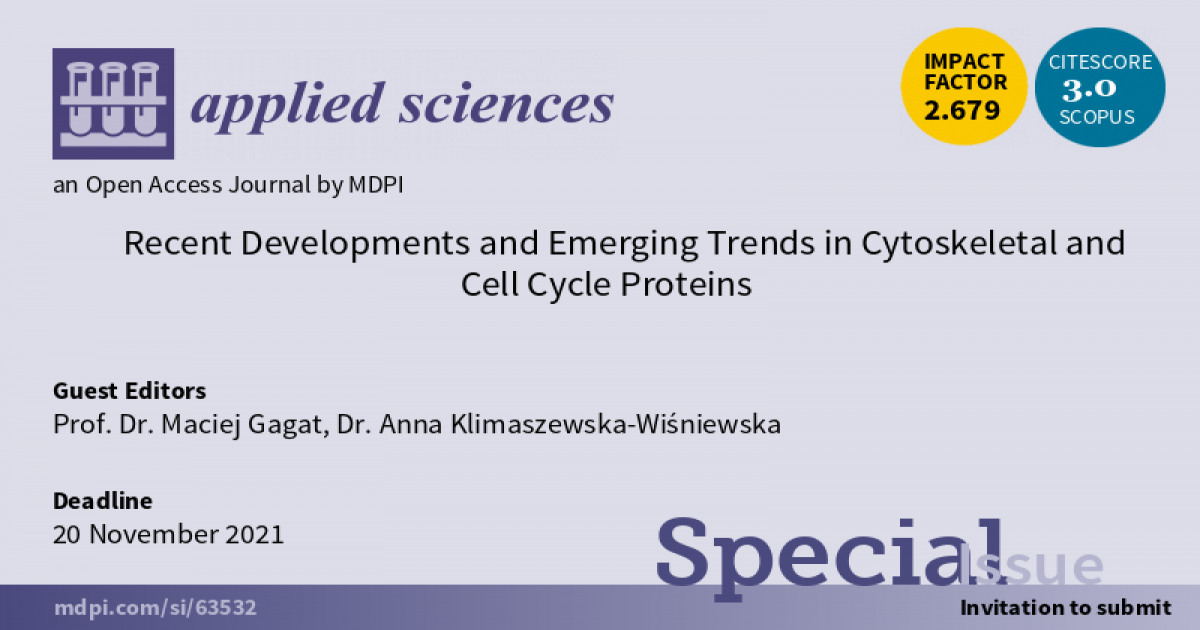Recent Developments and Emerging Trends in Cytoskeletal and Cell Cycle Proteins
A special issue of Applied Sciences (ISSN 2076-3417). This special issue belongs to the section "Applied Biosciences and Bioengineering".
Deadline for manuscript submissions: closed (20 November 2021) | Viewed by 15710

Special Issue Editors
Interests: cytoskeleton; cell adhesion; cell-cell junctions; cell migration; endothelial dysfunction; cell death; cancer biomarkers
Special Issues, Collections and Topics in MDPI journals
Special Issue Information
Dear Colleagues,
Since the cytoskeleton is an essential cellular component involved in virtually all cellular processes, it is therefore not surprising that, in recent years, cytoskeletal research has revolutionized cell biology and biomedicine. Our understanding on the intimate multiple-direction connection between this cellular structure, cell division, and other cytoskeleton-driven processes, in the context of both normal and abnormal cell function, is still increasing, and currently is directed toward the development of novel diagnostic and therapeutic strategies in various diseases such as cardiovascular disease and cancer. Likewise, an increasing amount of studies have implicated new and existing cell cycle regulators in many cellular transactions beyond cell cycle control, unveiling their involvement in more general processes such as DNA repair, transcription or cytoskeleton dynamics. It is clear that continued efforts in investigating these aspects of cell biology will further transform our understanding of diseases associated with cell cycle and cytoskeleton dysfunction, and may provide additional points of crosstalk between cell cycle machinery, cytoskeletons, and the associated proteins for more complex therapies.
This Special Issue is therefore devoted to presenting new trends in cytoskeletal and cell cycle research that specifically go beyond the traditional approach of the identification of new proteins and their functions, but also defining how these proteins interact and interfere with signalling pathways. This issue is also focused on basic studies of the alternative functions of cytoskeletal and cell cycle proteins in health and disease. Finally, presentations of new therapeutic agents, especially those originating from natural plant products, that act on these cellular targets are also highly welcome.
Keywords
- cytoskeleton
- cytoskeleton-associated proteins
- cell cycle
- new cell cycle players
- non-canonical functions of cell cycle proteins
- crosstalk between cell-cycle and cytoskeleton
- DNA damage repair
- DNA transcription
- cancer
- cancer biomarkers
- cancer metastasis
- epithelial-mesenchymal transition
- mesenchymal-epithelial transition
- cardiovascular disease
- endothelial dysfunction
- cell proliferation
- cell death
- apoptosis
- mitotic catastrophe
- autophagy
- cell migration
- cell adhesion
- cell-cell junctions
- live-cell imaging
- drug targets
- natural plant products
- medical devices
- treatment strategy
Benefits of Publishing in a Special Issue
- Ease of navigation: Grouping papers by topic helps scholars navigate broad scope journals more efficiently.
- Greater discoverability: Special Issues support the reach and impact of scientific research. Articles in Special Issues are more discoverable and cited more frequently.
- Expansion of research network: Special Issues facilitate connections among authors, fostering scientific collaborations.
- External promotion: Articles in Special Issues are often promoted through the journal's social media, increasing their visibility.
- e-Book format: Special Issues with more than 10 articles can be published as dedicated e-books, ensuring wide and rapid dissemination.
Further information on MDPI's Special Issue polices can be found here.





